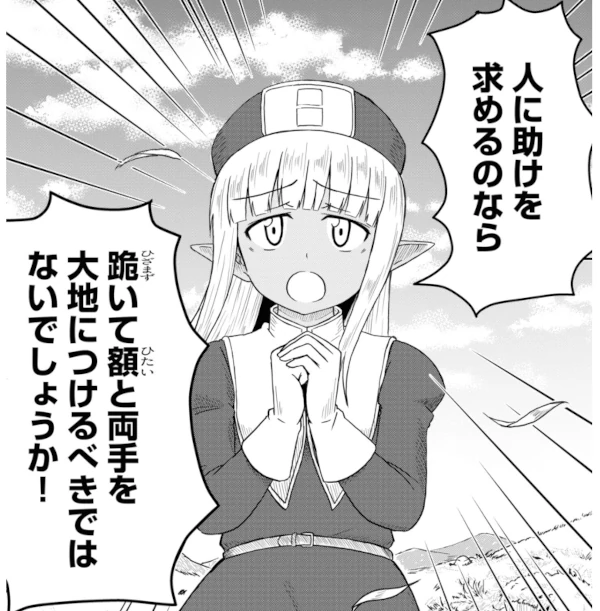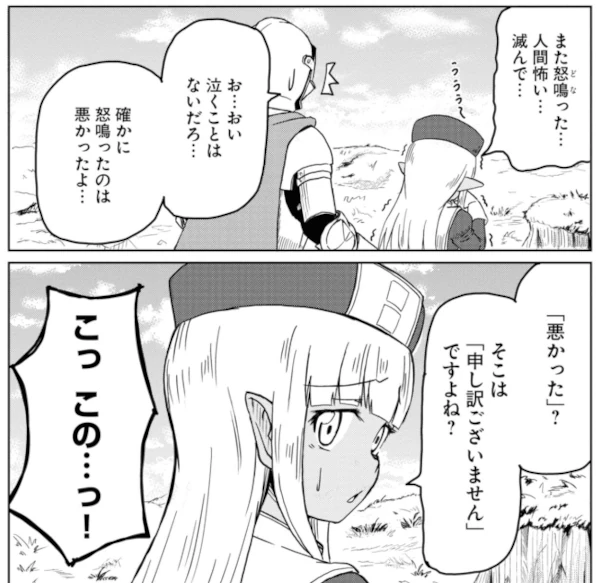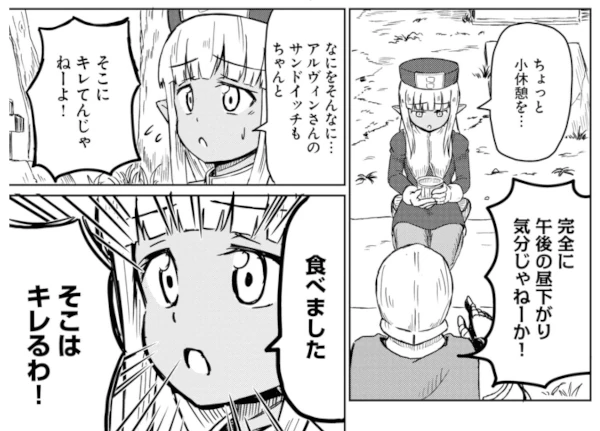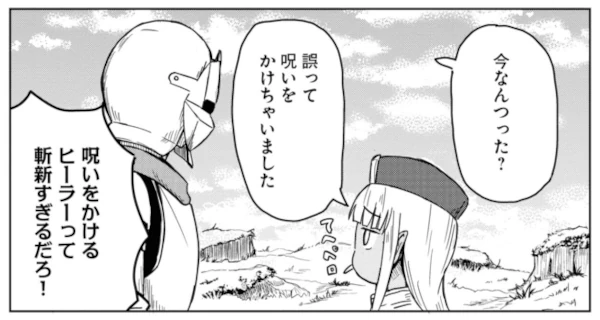This time, we’re introducing Don’t Hurt Me, My Healer!—a hilariously offbeat isekai manga where you’ll discover the surprisingly rich world of sarcastic polite speech and comedic banter. Perfect for Japanese learners looking to laugh while picking up edgy, expressive language.
Work Information

Don't Hurt Me, My Healer!(このヒーラー、めんどくさい)
Author: Tannen ni Hakkō
Publisher: KADOKAWA
Amount of text: moderate
Challenge level: ★★
Latest volume : Vol.8(Sep.2024 / Ongoing)
Story overview
So Annoying… Yet So Lovable?! A Buzz-Worthy Isekai Comedy About Hopeless Adventurers!
She’s a healer… who mocks, teases, and roasts instead of helping!
“What? You want me to cast a healing spell?” “Sorry, I totally lose motivation when someone gives me orders…”
A cult-hit web manga finally comes to print! Meet Karla, a priestess with zero healing vibes and an insanely high level of sarcasm— and Alvin, a warrior whose comebacks are sharper than his sword!
Together, they stumble their way through an absurd isekai world in this chaotic, offbeat adventurer comedy!
The Appeal of This Manga
Set in an RPG-style fantasy world, this gag manga kicks off when a rookie adventurer crosses paths with a self-proclaimed healer. The “healer,” Karla, constantly mocks, teases, and provokes—while the warrior Alvin spends every moment throwing witty comebacks her way. The result? A never-ending, hilariously fruitless exchange where no normal conversation ever takes place.
Karla is a master of irritating others without even meaning to—and if you find yourself charmed by her antics, there may be no escape. You’ve been warned.

Why this manga is suitable for learning Japanese
This manga is not only entertaining but also highly recommended for Japanese learners for several reasons.
The Birth of “Polite-But-Sarcastic” Keigo
Karla’s signature twist is that no matter how sarcastic or mean-spirited her words are, she always uses polite Japanese. For learners, this offers a rare chance to study a form of keigo (honorific language) that doesn’t show respect—but rather gets under people’s skin. Whether you’ll ever use it yourself is up to you—but it’s a fascinating new shade of Japanese to observe.

Plenty of “Tsukkomi” Lines to Learn From
Throughout the series, Alvin delivers non-stop tsukkomi—sharp, well-timed retorts that are a staple of Japanese comedy. In modern Japan, being good at tsukkomi is seen as a valuable communication skill, especially among friends or in casual situations. While Alvin doesn’t speak in formal language, his witty responses offer a useful reference for learners interested in natural, everyday Japanese with a comedic edge.

Phrase Spotlight
Talk Like a Comedian? Understanding Japanese Humor in Daily Speechボケとツッコミ(Boke and Tsukkomi)
If you’ve watched Japanese comedy, anime, or dramas, you may have noticed a pattern of one person saying something silly or absurd, and another quickly pointing it out with a sharp or funny response. This dynamic is known as “boke and tsukkomi”, and it’s a deeply rooted part of Japanese humor—and increasingly, everyday conversation.

Origins in Kansai Comedy
The boke–tsukkomi style comes from traditional Kansai-style manzai, a form of stand-up comedy where two performers exchange fast-paced dialogue. The boke (“blur” or “airhead”) says something offbeat or nonsensical, and the tsukkomi (“butt in” or “retort”) snaps back with a correction or witty comeback. It’s not just slapstick—it’s a rhythm, a shared sense of timing, and a cultural form of “play-fighting” through words.
In many cases, these names are created within tight-knit social circles such as classrooms, clubs, or sports teams.
From Stage to Screen—and Daily Life
Thanks to Japan’s comedy boom in recent decades, this style has become widely popular across the country—not just in the Kansai region. You’ll now see boke-tsukkomi exchanges in a wide range of media:
・TV dramas
・Manga and anime
・Variety shows and talk shows
Even in casual, real-life conversations—especially among friends or coworkers—you might hear people naturally fall into this dynamic.
For example:
A: 「今日、傘忘れた…」
B: 「なんでこんな大雨の日に!?」
Here, person A forgets something obvious (boke), and person B quickly calls it out (tsukkomi). It’s playful, not mean-spirited, and often signals closeness or familiarity.
A Double-Edged Sword
While this humor style has become a mainstream part of Japanese social interaction, there are some cautions:
・Not everyone wants to be a boke or a tsukkomi, especially in serious or unfamiliar situations.
・Forcing this kind of exchange can feel unnatural or even uncomfortable.
・Humor varies by region, generation, and personality—so context matters.
In other words, boke-tsukkomi is a fun and uniquely Japanese way of joking and bonding, but it shouldn’t be treated as a universal rule. Sometimes, a simple laugh and nod go further than a perfectly timed comeback.
Why It Matters for Learners
Understanding the boke–tsukkomi style can help learners of Japanese better interpret dialogue in media and daily interactions. You’ll start to see that a quick retort isn’t necessarily rude—it can be a sign of affection or playfulness. Just remember: timing, tone, and mutual trust are everything.
So next time you hear a character say something outrageous and another shout back in surprise, you’re not just watching a joke—you’re seeing a piece of Japanese cultural rhythm in action.
A Little Warning
Karla Is… a Lot
As the title suggests, Karla is downright exhausting. Her overly complicated and annoying behavior might frustrate some readers. If you’re not into that kind of humor, sticking with the series could be a challenge. But if you’re even a little intrigued—beware. You might just get hooked.

Work Information

Don't Hurt Me, My Healer!(このヒーラー、めんどくさい)
Author: Tannen ni Hakkō
Publisher: KADOKAWA
Amount of text: moderate
Challenge level: ★★
Latest volume : Vol.8(Sep.2024 / Ongoing)
Here’s a safe and convenient way to purchase Japanese manga.
This Blog’s ConceptIn this blog, we are introducing manga that are not only highly captivating but also ideal for Japanese language learners. Studying Japanese through manga is both fun and effective. Manga allows you to understand the subtleties of keigo (honorifics), teineigo (polite speech), and casual conversation in Japanese. We hope you find works that match your interests and use them to enhance your Japanese learning journey.